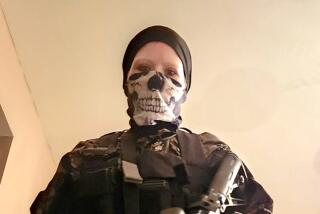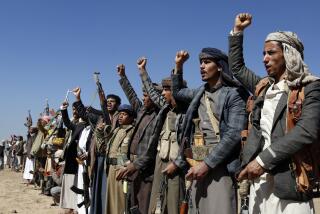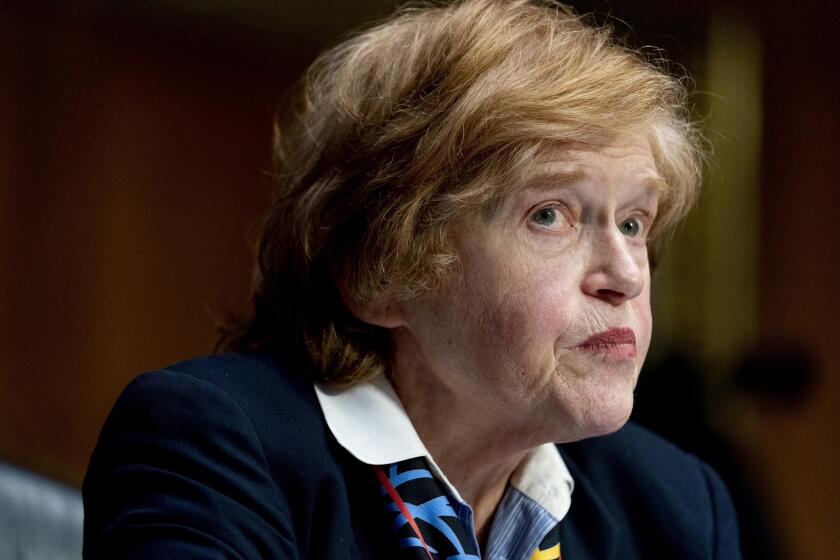Indonesia Cleric Tied to ’95 Anti-U.S. Plot
An Indonesian cleric who has been linked to two Sept. 11 hijackers was also the business partner of an Afghan terrorist and helped him finance a 1995 plot to blow up 12 U.S. jetliners over the Pacific Ocean, according to documents and officials in Malaysia and the Philippines.
Riduan Isamuddin, 37, has emerged in recent weeks as the Southeast Asia operations director for Osama bin Laden’s Al Qaeda network, officials say. But documents reviewed by The Times indicate that his involvement in plots against U.S. targets dates to at least 1994. Isamuddin, now better known as Hambali, was identified by authorities recently as the leader of a plot to blow up the U.S. Embassy in Singapore.
Revelations about Hambali’s early business ties to terrorists trained in Bin Laden’s camps and his involvement in Asian plots make his role in the global terror network appear more central than previously thought.
The new information links the Indonesian preacher to a plot that could have killed thousands of people and gave investigators their earliest hint that terrorists were planning to crash hijacked planes into important buildings in the United States.
In June 1994, Hambali was one of the founders of the Konsojaya trading company here, and on Dec. 1 of that year, his partner in the firm, Wali Khan Amin Shah, helped bomb a Philippine Airlines jetliner.
A Japanese businessman was killed in the blast, which forced the jumbo jet to land in Okinawa. U.S. prosecutors said the bombing was a test for a much more ambitious plot to plant explosives in rapid succession on United, Northwest and Delta airlines jets bound for America’s West Coast from cities throughout Asia. The plot also included a plan to kill Pope John Paul II as a distraction while he was visiting the Philippines, court records show.
A freak accident and fire in January 1995 in the Manila apartment that served as the group’s bomb factory foiled the plans, which U.S. prosecutors said would have killed as many as 4,000 Americans in a 48-hour period.
Philippine police wiretaps showed that until the plot was discovered, Hambali’s company was in frequent contact with Mohammed Khalifa, Bin Laden’s brother-in-law, who headed a Manila-based charitable organization allegedly used to spread Bin Laden’s influence.
One of the plotters later told investigators in the Philippines that their ultimate goal was to hijack a commercial airliner and crash it into a government building in Washington--a plan that foreshadowed the Sept. 11 plot.
Involved with Khan--Hambali’s business partner--in the plot to bomb the 12 planes was Ramzi Yousef, who was also found guilty in the 1993 truck bombing of the World Trade Center, and Pakistani Abdul Hakim Murad. According to court testimony, all three had either been to terrorist camps or fought in the war against Soviet occupation of Afghanistan in the 1980s. All three were convicted by a federal jury in New York in 1996 in the plot to bomb the 12 planes.
Testimony during the trial showed that Khan used Malaysia as an unwitting logistics base and frequent transit point before the planned attack.
Khan was arrested in Manila after the apartment fire but escaped 77 hours later and fled to Malaysia. He was captured by Malaysian police 11 months later when they identified him by the three missing fingers on his left hand. Malaysian authorities immediately handed him over to the FBI.
Officials said they learned years later that Hambali had supplied Khan with a new identity and cover in Malaysia, where he lived on the resort island of Langkawi using the name Osama Turkestani.
Malaysian officials and a former Philippine investigator who headed the investigation into the case now say the Konsojaya company was central to the bombing plot, which was code-named Bojinka.
“According to my analysis, Konsojaya was the nerve center not only for business but also for operational supervision [of the plot to bomb the airplanes],” said Rodolfo Mendoza, the former head of Philippine counter-terrorism who led the Bojinka investigation.
Mendoza added that he believes Hambali’s role in the corporation meant that he also was a key participant in financing and organizing the terror plot.
Corporate records on file in the Malaysian capital show that Khan, who was on Konsojaya’s board of directors, owned half the company’s 6,000 shares. Other company documents show that Hambali and his Chinese Malaysian wife, Noralwizah Lee, also were among the company’s founding directors.
Other Konsojaya directors included another Afghan, Mehdat Abdul Salam Shabana, who owned the other half of the company’s shares, and Hemeid H. Algamdi, described as a 30-year-old Saudi Arabian from Jidda, records show.
Konsojaya’s managing director is listed as Amein Mohamed, a Yemeni who is described in a company profile circulated to suppliers and customers as the former marketing director of a Pakistan-based buying agent for a Saudi company in Jidda.
Other than Khan, the whereabouts of the former directors today is unknown, and Hambali is the first to be linked to other terror plots.
Hambali is wanted in Malaysia and Singapore in connection with a plot to bomb U.S. and other Western targets in the region two months ago. He also is wanted in his native Indonesia for his alleged role in a series of bombings on Christmas Eve 2000. Some officials believe he may be hiding in Indonesia. More than 40 people linked to Hambali have been arrested in Singapore, Malaysia and the Philippines since December.
In January 2000, Hambali put up two of the Sept. 11 hijackers and a suspect in the bombing, in Yemen’s Aden harbor, of the U.S. destroyer Cole, which occurred in October of that year. He housed them at a condo near Kuala Lumpur owned by alleged disciple Yazid Sufaat, who was arrested by Malaysian authorities Dec. 9.
Konsojaya stated in its incorporation papers that it was exporting Malaysian palm oil to Afghanistan, and described its principal objective as “exporting all kinds of products from Malaysia and the Asia Pacific region to Saudi Arabia, Bahrain, Afghanistan and Sudan.”
But Philippine and Malaysian investigators now say Konsojaya was exporting more than just palm oil.
“My analysis is that Konsojaya was formed for the purpose of terrorist activity,” former investigator Mendoza said in a telephone interview Wednesday. “During that time, they were already expanding in Singapore. They were active in Indonesia, in Jakarta [the capital].”
Malaysian officials say they too believe Konsojaya was a funding conduit for the Bojinka plot and a cover for Khan. David Greenfield, Khan’s court-appointed attorney in the 1996 trial, introduced the Malaysian company’s records during the trial as evidence that Khan had legitimate business in Malaysia.
To neighbors near the simple shack an hour from Kuala Lumpur where Hambali lived with his wife in 1994, his business appeared legitimate. His landlord in the secluded compound knew Hambali only as a small-time businessman and preacher.
“Although we have had a very good record of coming down on extremists--even Islamic extremists--a lot of these groups go about their business quietly, and it’s very difficult to discern exactly what they are doing,” one Malaysian official said this week. “A group like this was able to operate without drawing much attention to themselves.”
Connections between the Asian terrorists and Bin Laden were long hidden. The U.S. government’s case against Khan and the others for plotting to bomb the planes began just days before a federal grand jury in New York started investigating Bin Laden and Al Qaeda. It never mentioned the names of Bin Laden or his group.
Through the 1996 trial, prosecutors cast the Kuwait-born Palestinian Yousef, a man who remains so mysterious no one is certain of his real name, as the mastermind of the bombing plot.
Testimony in that trial showed that Yousef surfaced in Singapore in the fall of 1994 with Khan at his side. There, they got Philippine visas while in transit to Manila.
“My observation is that Ramzi Yousef was considered the most important,” Mendoza said. “But it is the other way around. The most important was Wali Khan and the board of directors in Malaysia.” Among those directors was Hambali.
Assistant U.S. Atty. Michael Garcia, who prosecuted the case, described during the trial how Khan used various passports and fake identities to move undetected through Malaysia, Singapore and the Philippines.
The bomb plot relied on explosives that used modified Casio watches as detonators and bomb materials that could not be detected by airport scanners.
The devices were to be placed under the seats of U.S.-bound American jetliners originating in Asian cities with interim stops. Yousef, Khan, Murad and at least one other cell member who was never captured planned to board the planes, plant bombs under strategically located seats to blow out the planes’ hydraulics, then disembark in the interim cities. There, each would board another targeted jetliner.
Detailed itineraries already were on the hard drive of Yousef’s laptop computer, which was seized by Philippine police after neighbors alerted firefighters to the smoke in the group’s apartment.
Murad was caught when he returned to the apartment to fetch Yousef’s computer. Yousef fled to Pakistan, where a new recruit turned him in to local authorities a month later, testimony showed. A week after the fire, Khan was arrested at his girlfriend’s Manila apartment, where police found the fake passports, bomb material and other evidence introduced at trial.
During two months of interrogation by Philippine authorities, Murad, who attended flight schools in America as early as 1992 and had a pilot’s license, said his ultimate goal was to hijack a U.S. airliner and crash it into either CIA headquarters or the Pentagon.
Khan has said little to investigators. He told FBI agents escorting him to New York after his arrest that he knew nothing about the Bojinka plot. He did not testify at the trial.
According to corporate records in Kuala Lumpur, Konsojaya is now defunct.
“The most critical question now is, ‘Where are the other former directors of Konsojaya?’ ” Mendoza said.
A letter found in Yousef’s room when Pakistani authorities tracked him down at the Su Casa Hotel in Islamabad in February 1995 was a reminder of the high stakes involved.
Introduced in evidence during the 1996 trial, the letter was cast by prosecutors as a ransom note to win Murad’s release from Philippine custody. It isn’t clear from the court record whether the letter was ever sent.
“We are going to take the harshest of measures in order that all Filipino interests inside and outside the Philippines will be subject to destruction,” an Arabic translator read from it in court. “Our measures will include assassinating some prominent figures, foremost among them the Filipino president. They will also include hitting numerous aerial targets. . . .
“We also have the ability to make and use chemicals and poisonous gas . . . for use against vital institutions and residential populations and drinking water sources and others.
“And if our request is not answered positively, in addition to everything we have mentioned, we shall train the Muslims in the south [of the Philippines] to do this. And these gases and poisons are made from the simplest ingredients. . . . And we could, as well, smuggle them from one country to another if needed.”
*
Fineman reported from Kuala Lumpur and New York. Paddock reported from Jakarta.
More to Read
Sign up for Essential California
The most important California stories and recommendations in your inbox every morning.
You may occasionally receive promotional content from the Los Angeles Times.






